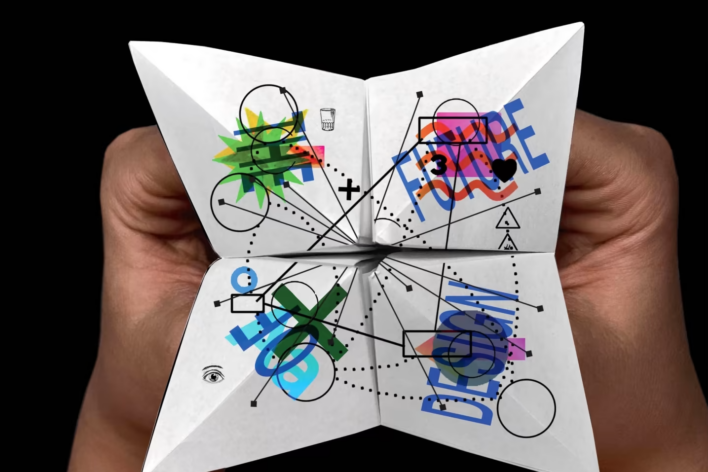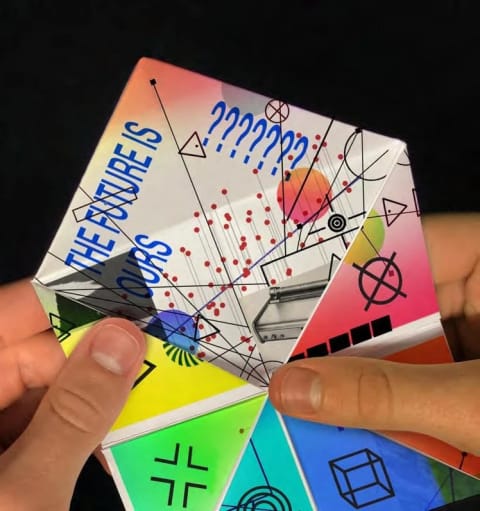
SVA Design Leaders on Their Ever-Changing Field
The graphic design industry has gone through seismic shifts since the SVA introduced its first design major in the 1970s, let alone since 1955, when the College introduced its first course in the field, taught by renowned designer George Tscherny. The graphic design profession, once largely reliant on the advertising and publishing industries, has become a discipline seemingly without limits or simple definition. Designers’ work is now omnipresent, shaping digital interfaces, physical environments, business tools and the culture at large. In this sense, it is more consequential than ever, with growing awareness among its practitioners and the general public that decisions made at the drafting table can have immense and unintended consequences—in some cases, either contributing to the planet’s salvation or consigning it to further doom.
To get a sense of how design has changed, we spoke with BFA Advertising and BFA Design Chair Gail Anderson (BFA 1984 Media Arts), MFA Interaction Design Chair Liz Danzico, MA Design Research, Writing and Criticism Chair Molly Heintz (MFA 2011 Design Criticism), MFA Design Co-chair Steven Heller, former faculty member Barbara Nessim, MFA Design for Social Innovation Chair Miya Osaki, MFA Design Co-chair Lita Talarico, former MFA Design Criticism Chair Alice Twemlow and former BFA Advertising and BFA Design Chair Richard Wilde.
What would you say is the single most significant shift within the design discourse since you began teaching? What has not changed—or not changed enough?
Barbara Nessim The most significant shift is the multitude of ways that design and illustration are delivered to an audience and the time that people have available to look at them, or the lack thereof. Our 24-hour day is getting shorter and shorter by greater time demands, a shrinking economy and globalization.
In the 1940s, ’50s and ’60s, one could ponder over an illustration by the likes of Norman Rockwell, for example. People were buying magazines like The Saturday Evening Post, which featured illustrations; Life, which was photography-based; and Look, which gave birth to photojournalism. One could study the details of a visual and gather information through the lens of realism.
Fast-forward to today: the length of time a person spends receiving visual information has shortened as attention spans are divided by all the distractions and media that is blasted out in the world. We have lost the luxury of time.
Richard Wilde The computer impacted design and advertising beyond our wildest dreams—everything was at the designer’s fingertips and the possibilities of creating numerous solutions to any given project, in turn, gave the designer greater options for success. Its impact was profoundly felt on every level of the industry, and it positioned the design community as an integral part of the larger world of communication. Design was no longer a service business but could function as an end in itself. Interaction design and motion-graphic technology greatly enhanced the scope of what a designer could be.
Steven Heller I would argue that there is little design discourse today. The late 1980s and ’90s was the peak of volatile design debate and philosophical alignment. Today, there is more acceptance of diversity, not just individual diversity but aesthetic, pragmatic and philosophical ways of making and going. Designers seem less concerned with style than function. This is neither good nor bad, just a different package of concerns triggered by issues of sustainability, politics and freedom of expression.

Lita Talarico In the beginning, we were waiting for the technology to catch up to the students’ imaginations. When the technology came, it just continued to expand design, particularly with regard to entrepreneurship. Maybe 10 or 12 years ago, we got to the point where you could create an MVP [minimum viable product] in-house and on a much shorter timeline—the whole process of iteration changed.
The danger with technology is there’s always this notion of, “Let’s take the designer out of design.” That’s what happened with desktop publishing; it promoted the idea that people with no background in typography or layout could create their own newsletters. And it’s always a false promise. To have good design, you always need a designer.
Gail Anderson The game changer for all of us was the Internet and its endless scrollable information. Students are worldlier, savvier and better informed. Their expectations are higher, and they have the opportunity to enter an industry that offers them a seat at the table as equals to the big shots—the Larry Tates. They are much more fully formed than I was in 1984 and certainly voice more opinions than I felt I was allowed to at their age (too much Catholic school for me). It’s not about entitlement—it’s about access and confidence.
Liz Danzico The most significant shift has been access.
Designers and makers have access to more tools, more choices, more people, more inspiration and more stories of success and failure. Consumers have more access to good and bad design, which makes them more discerning. Of course, this is only true for people who have access to devices and/or WiFi. But it’s sweeping enough to have deeply impacted our industry.
Alice Twemlow In 2008, design and design writing and research considered its engagement with remediating the climate crisis as something optional, its complicity in engendering the Anthropocene as something that could be offset with environmentally friendly paper choices. Now, of course, things are very different. Everything we do, whether it’s being a designer, writer, or educator, is centered on the issue of climate justice.
Molly Heintz After the 2016 election, conversations took on a new urgency among our faculty and older alumni, who understood what was at stake with the shift in political power. It took more time for the students to understand that design is political, but they started to see it every day in the newspaper, from design proposals for the border wall to a mandate for all new federal buildings to be in the classical style. The political climate, the #MeToo movement and the Women’s March, the stark inequities exposed by the pandemic and the Black Lives Matter movement have shifted the design discourse to focus on social justice, equity and inclusion. There is a long way to go yet. But one indicator of progress is that many designers would think about (and answer) the question “What is good design?” in a different way than they would have 10 or even five years ago.

Miya Osaki We have a stronger sense of how much healing the world really needs. We’re taking a hard look at consumerism and how that has really driven a lot of design. I even take issue with the word sustainability these days. Are we sustaining companies, or are we trying to make sure that nature is respected and can regenerate?While human-centered design might work well for products, it falls short and can even be harmful in a service and systems-design sense. It doesn’t really allow for deep relationships, nor does it allow us to understand each other. Our current methods of design need to be questioned and reimagined with greater care.
Where do you sense the industry is heading? What kinds of opportunities await SVA students and new graduates?
Nessim When I was 25, an older person who was 50 asked me what I wanted out of life. I really thought about it for a few long and silent minutes and answered, “I want to be true to myself.” This person said, “Don’t be so corny.” I was taken aback! Now at 83, with a successful and happy life, I would give the same answer.
Another major change will be in cryptocurrency, blockchain technology and NFTs. These will be as important a game changer in all industries as computers were in the 1980s.
Wilde It’s difficult to predict what the future holds.
What is encouraging is that there exist opportunities for new graduates, as they would be the first to embrace new technologies as they unfold. This merger of combining a high level of ideation, which is what SVA is known for, makes the possibilities seem vast.
Heller There will be more opportunities to employ new technologies. Graphic design will continue to merge into product design, interaction design and who knows what else—assuming that the world does not blow itself to bits.
Talarico We’re about to celebrate MFA Design’s 25th anniversary, and we’re planning an alumni and faculty summit about this, talking about the next 20 years for the industry. It’s just going to expand more and be inclusive of media, platforms . . . opportunities that we have not even considered yet.
The industry will always be changing, so you have to have a strong foundation of skills and be resilient and adaptable. Good design depends on critical thinking, communication, collaboration and creativity—that never changes.
Anderson Now our graduates will be able to work from small towns, beaches and the tops of mountains—they don’t have to be cooped up in offices five days a week if they choose not to. I’m excited about the new crop of design and advertising professionals. They’re less single-minded than I was and have all kinds of crazy new media at their fingertips.
Danzico The industry has an opportunity and a responsibility to listen, shape and act—that last verb is not optional, by the way. Designers have the particular benefit of being in the business of shaping the future. And where we stand right now, is at a tremendous opportunity for design.
We happen to be on the precipice of two important moments: For lack of a better term, we’re turning a page on a new chapter being termed as “Web3” and with it comes a host of new opportunities for designers and the industry. It’s fitting for us, since our program began at the relative start of “Web2.” The blockchain, cryptocurrency, interactions in one or more metaverses and other interactions yet to be defined are all emergent ideas and/or systems to be shaped, refined and reckoned with. And the industry has a critical role to play in humanizing the intersections across areas of life.
Twemlow What’s new and particular right now, of course, is the urgency of the socio-political-environmental crises.
It may be the case that we’ll see graduates heading not so much to jobs in existing design firms in the U.S. but rather to setting up their own initiatives and platforms based on the issues they care most about, which may also lead them to spaces and geographical locations not traditionally associated with design. I’m quite excited about this development, where the full spectrum of skills, methods, approaches, theories and ideas that we introduce them to in their design education can be put to the test, in situations where it really matters.
Heintz The design industry is starting to understand that engaging with social justice is not only about the projects you work on. It’s about your own studio and diversifying the voices and life experiences around the table and empowering those voices to be leaders. The same goes for design publications. It’s not just about covering diverse designers. It’s also about giving that byline to a new storyteller. And the same goes for schools. Bring in new faculty and change up the syllabus, readings and guest speakers from the usual suspects to create an environment where a wider array of students can feel safe, feel heard and thrive.
Osaki There’s a need for new design leadership—pathways that are more diverse and intersectional and abundant. There’s also a need for decentralization in the industry. While keeping things interconnected, acting locally may allow us some freedom to explore and dream.
A version of this article appears in the fall/winter 2022 Visual Arts Journal.
Anne Quito (MFA 2014 Design Criticism) is a journalist and design critic. She wrote Mag Men: Fifty Years of Making Magazines (2019) with Walter Bernard (1961 Graphic Design) and the late Milton Glaser, a longtime SVA faculty member and former acting chairman of the College’s board.
More related links
- “The goal is to build civic curiosity, knowledge, and leadership." | Pilar Finuccio (MFA DSI '18) at the Center for Urban Pedagogy Blog
- Meet 2025 SVA Alumni Scholarship Winner Héctor Ruiz (MFA DSI '25) Blog
- Amplifying Women in Innovation Fields | WIN Awards 2025 Blog
- "The Cross Bronx Expressway, through the lens of the communities who live alongside it" | Alejandra Saker (MFA DSI '24) Blog